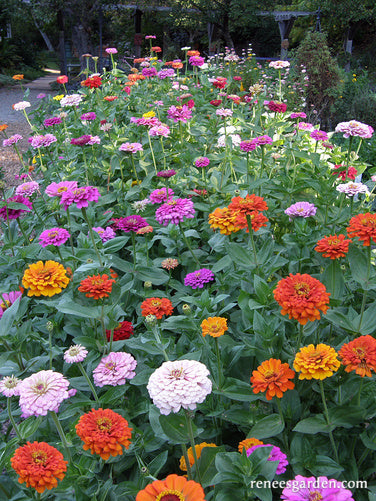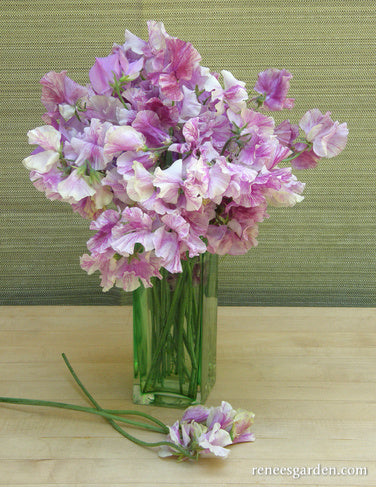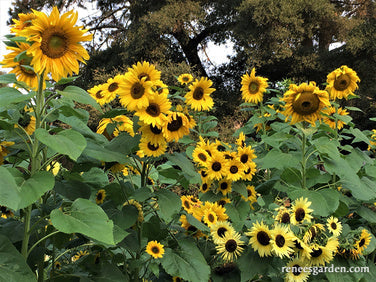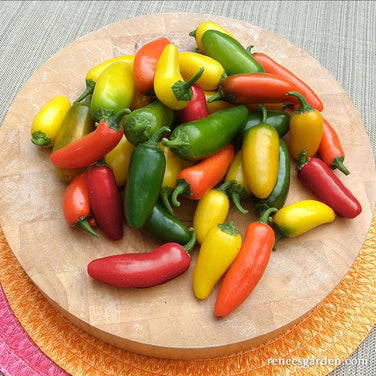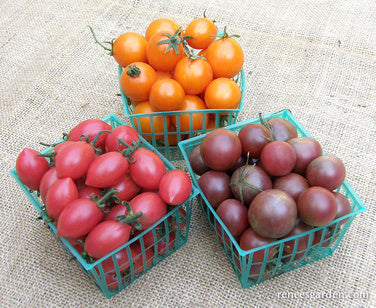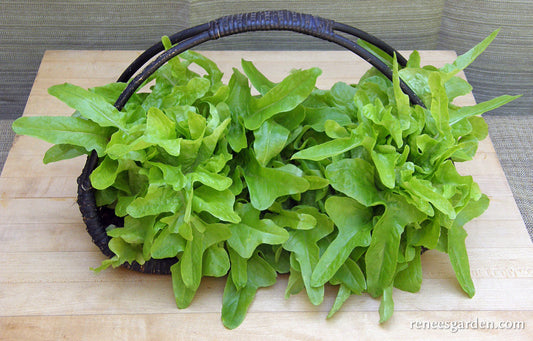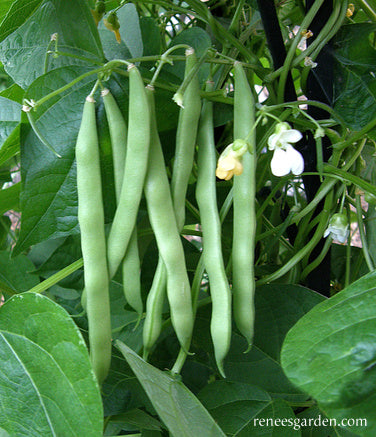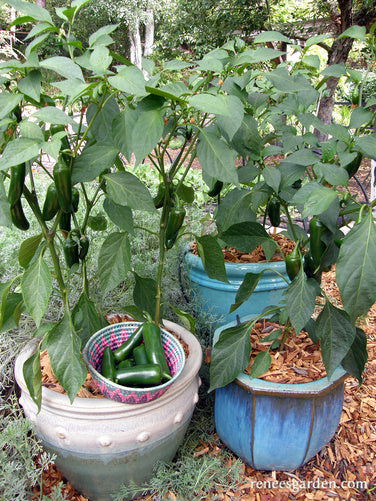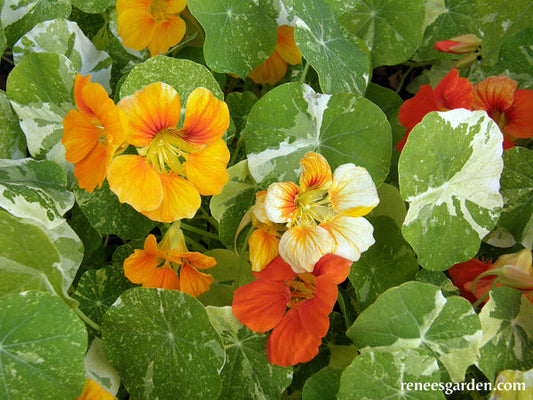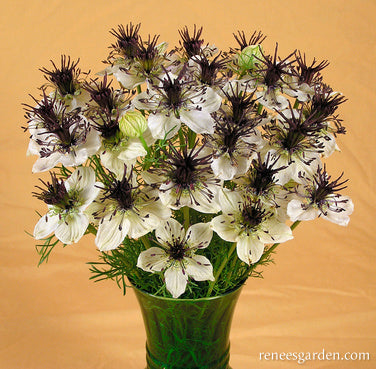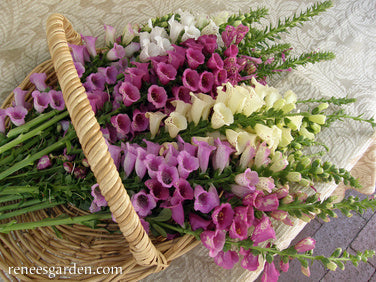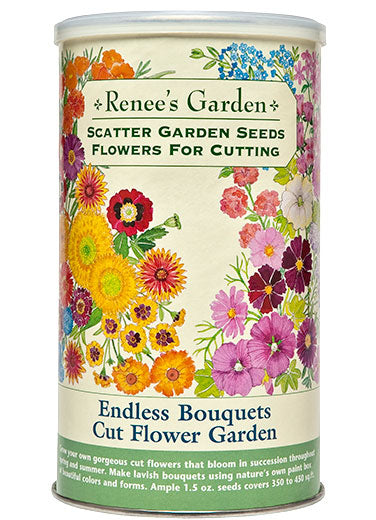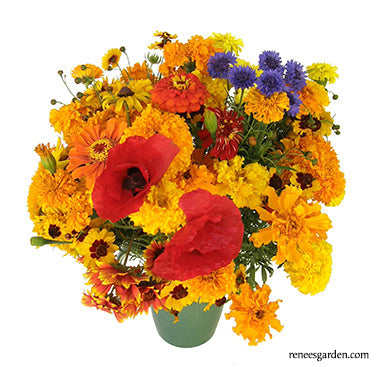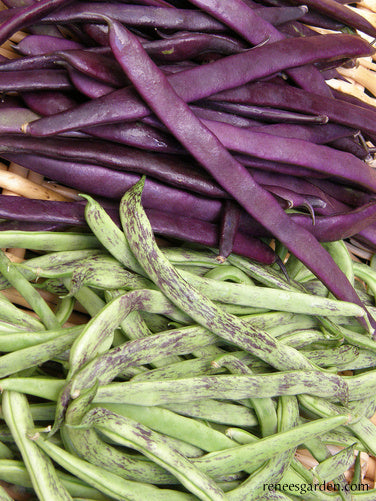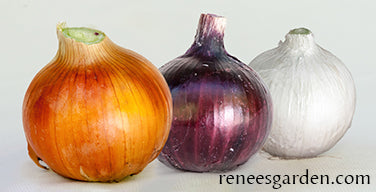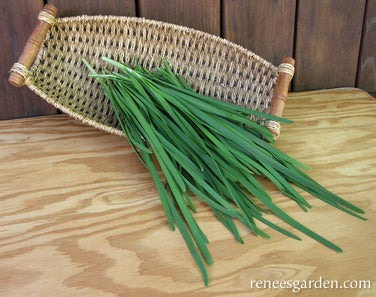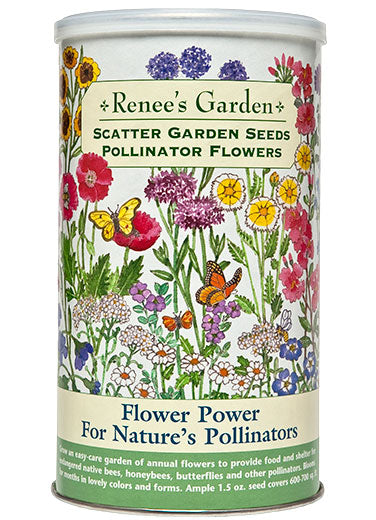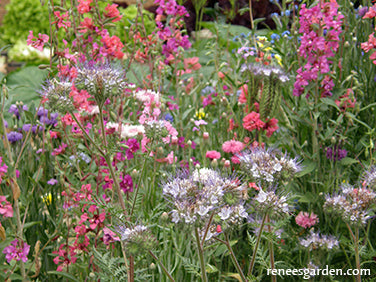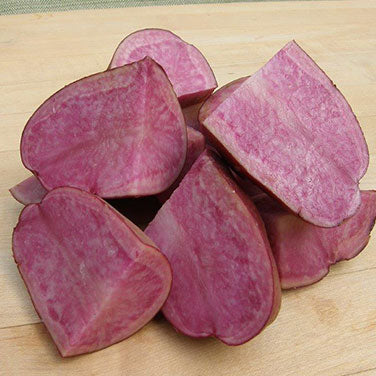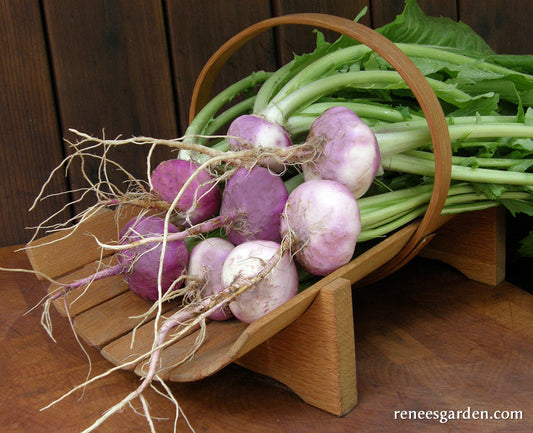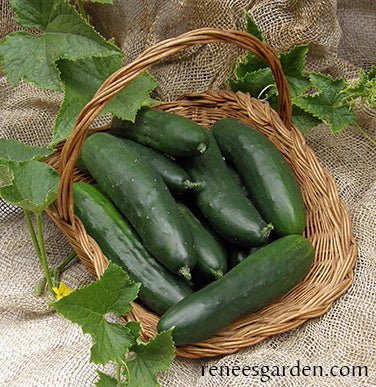Heirloom Selections
Old Varieties with Exceptional Beauty and Flavor
Our heirloom selections have been preserved and kept true to their beloved local history, often exhibiting unusual colors, shapes or flavors.
-
Heirloom Rainbow Flowers Colorful, Carefree Zinnias
NOTE
Seeds in this canister are packed with a larger quantity of organic rice hulls to help space them. Before opening, shake canister thoroughly to mix.
HOW TO PLANT AND GROW
When spring weather is warm and settled, and nights are reliably above 50°F (10°C), prepare planting area by removing all weeds, grass, stones and large clumps. Loosen the top 2 inches of soil with a digging fork or shovel, then smooth with a flat rake.
Scatter mix thinly and evenly. Using your rake, work to cover the seeds with 1/2 inch of soil, then use planting mix or compost to cover any exposed seed mix. Water thoroughly with a gentle mist.
Protect tiny seedlings from birds by using netting or ribbons of shiny, reflective flash tape at planting time. Keep weeded and watered; when 3 inches tall, remove covering and thin seedlings to 8-10 inches apart for good air circulation and enough elbow room to grow, branch and bloom freely.
HARVEST AND USE
For bouquets, pick just as flowers open, cutting long stems well back into the plant to keep them branching. Butterflies, bees, and other native pollinators will seek out and work these pretty flowers that provide them with nectar, pollen and shelter.
Zinnias are carefree and long-lasting, but will thrive and bloom longer with proper thinning, regular watering and several applications of organic fertilizer over their long flowering season.
Regular price $16.95Sale price $16.95Unit price / per -
Heirloom Summer Garden Dancing, Joyous Sunflowers
NOTE
Seeds in this canister are packed with a larger quantity of organic rice hulls to help space them. Before opening, shake canister thoroughly to mix.
HOW TO PLANT AND GROW
When spring weather is warm and settled, and nights are reliably above 50°F (10°C), prepare the planting area by removing all weeds, grass, large clumps and stones. Loosen the top 2 inches of soil with a digging fork or shovel, then smooth with a flat rake.
Scatter mix thinly and evenly. Using your rake, work to cover the seeds with 1/2-1 inch of soil, then use planting mix or compost to cover any exposed seed mix. Water thoroughly with a gentle mist.
Keep weeded and watered; protect tiny seedlings from birds by using netting or ribbons of shiny, reflective flash tape at planting time. When 3-4 inches tall, remove covering and thin seedlings to 10-12 inches apart. This spacing is critical for sturdy, windproof plants with good root systems and large flowers.
HARVEST AND USE
For bouquets, cut when flowers just begin to open. Many diverse pollinators will busily visit the florets in each flower head and seeds will begin to mature. When the center disk florets have dried, birds will happily snack on ripening seed heads.
Harvest for winter feeding by covering ripening heads with paper bags until kernels are plump and hard shelled. Cut entire heads; store until cool and dry, then remove seeds. Store in closed containers to feed as needed.
Regular price $16.95Sale price $16.95Unit price / per -
Giant Harvest Gourds Lunch Lady
BEST TO START SEEDS INDOORS
Several weeks before last spring frost date, sow 2 seeds each, 1 in. deep, in individual pots of potting mix. Keep warm and moist and provide a strong light source. When nights stay above 50°F (10°C), thin to one seedling per pot and gradually acclimate to outdoors. Transplant at along a sturdy fence or trellis to climb effortlessly and form a lush canopy or allow vines to ramble at garden edges.
START DIRECTLY OUTDOORS
Sow seeds directly outdoors only if you have a long growing season. Sow only after night temperatures stay solidly above 50°F. (10°C). In full sun, sow seeds 1 inch deep and 4 inches apart along a garden fence or sturdy trellis or along garden edges. Thin seedlings to final spacing 8 inches apart.
GROWING NOTES
Unique Lunch Lady gourds need full sun, rich soil and warm temperatures. For earliest and best yields, hand-pollinate gourds: pick a blooming male flower and dust pollen onto fresh female flowers (the ones with small fruits at the base).
Repeat as new flowers appear. Pollinated fruits start growing larger within several days. Gourds are mature when rinds are tough and the tendril next to the stem turns brown. Harvest with several inches of stem. Dry in a well-ventilated place.
Note: the flesh of Lunch Lady ornamental gourds has a bitter gene and is not edible.Regular price $4.69Sale price $4.69Unit price / per -
Fragrant Sweet Peas Raspberry Twirl
ANNUAL CLIMBING VINE
Spring/summer bloom
Frost tolerantEASIEST TO START OUTDOORS
Sweet peas must have well drained soil, so dig deeply and enrich with aged manure or compost before sowing seeds. Erect a well-anchored trellis, vertical netting or other support for vines before planting. Sow seeds in full sun in cool early spring weather as early as the ground can be worked.
In mild winters, where ground does not freeze, sweet peas can be planted in fall. Seedlings will form strong root systems, then overwinter to bloom vigorously in spring. Plant sweet pea seeds 1 inch deep and 2 to 3 inches apart. When seedlings are 2 inches tall, thin to 4-5 inches apart to allow plants room to mature.
GROWING NOTES
Sweet peas bloom best when they flower before the weather gets too hot, so if spring planting, sow as early as possible, especially in regions where summer heat comes on fast. Anchor climbing supports well as these vines will grow dense and heavy with bloom. Protect seedlings from birds, slugs and snails. Mulch and keep well watered for best flower production. For longest bloom, remove faded blossoms regularly.Regular price $3.99Sale price $3.99Unit price / per -
Bonus Pack An Heirloom Sunflower Forest
ANNUAL
Spring/summer bloom
Frost tenderEASIEST TO PLANT OUTDOORS
Plant in full sun in good garden soil only when weather is warm and settled, all danger of frost is past and both days and nights are evenly in the 50°F (10°C) range. Poke individual seeds into well-worked soil about 1/2 in. deep, 4 to 5 in. apart. Press the soil firmly over the seeds and keep the seedbed evenly moist until seedlings emerge in 8 to 10 days.
Important: when the seedlings are well-established, carefully thin them to a final spacing of 1 foot apart; this way they will have enough room to develop sturdy stalks that won’t blow over and big clusters of flowers. Any extra seedlings you need to remove can be transplanted elsewhere in the garden or potted up and given to friends.
TO START EARLY INDOORS
Several weeks before last frost date, sow seeds 1/2 inch deep in individual pots of well-drained seed starting mix. Keep moist and provide a strong light source until seedlings are well established and ready to plant outside. Transplant carefully, disturbing the roots as little as possible. Space seedlings 1 foot apart so plants will have room to grow and mature.
GROWING NOTES
Growing these colorful sunflowers for pollinators and bouquets is both easy and rewarding. Make several sowings several weeks apart and you’ll have a succession of flowers in full bloom. Keep soil moist and well weeded. Protect very young seedlings from bird predation by covering the bed with bird netting held tautly well above seedlings by supports. Or use plastic berry baskets, removing before plants get crowded.
Regular price $8.99Sale price $8.99Unit price / per -
Rainbow Jalapeño Chiles Spice Trio
STARTING SEEDLINGS
In early spring, start indoors about 2 months before night temperatures stay reliably 55°F (13°C). Sow seeds 1/4 inch deep and 1 inch apart in a container of seed starting mix. Keep moist but not soggy, and very warm 80-85°F (27-30°C). Provide a strong light source until seedlings are ready to plant outside.
When seedlings are 2 inches tall, transplant into deeper individual containers. Maintain at 70-75°F (21-24°C). Feed with half-strength fertilizer every week until weather is warm enough to gradually acclimate seedlings to outdoor conditions. Transplant 1 1/2 feet apart into rich soil in full sun.
GROWING NOTES
Jalapeños need warm conditions. Don’t transplant outdoors until night temperatures stay securely above 55°F (13°C). Prepare soil well with aged manure or compost. Plant only robust seedlings with well-developed roots. Mulch plants to maintain even soil moisture. Keep well weeded, watered and fertilized.
HARVEST AND USE
To harvest, cut rather than pull fruits from plants when fully colored up either bright red, rich orange or golden-yellow. These eye-catching, spicy baby jalapenos have thick juicy flesh. Slice and pickle them for zesty condiments, use for delicious rainbow salsas, fajitas or for cheese stuffed “poppers.”Regular price $4.89Sale price $4.89Unit price / per -
Cherry Tomato Trio Triple Treats
STARTING SEEDLINGS
Start indoors about 6 to 8 weeks before outdoor night temps are in the 50-55°F (10-13°C) range. Sow seeds ¼ inch deep and 1 inch apart in a container of seed starting mix. Keep moist but not soggy, and very warm, 80°F (27°C). Provide a strong light source until seedlings are ready to plant outside.
When they are 2 inches tall, transplant into 4 inch pots, burying stems up to base of leaves. Maintain around 70°F (21°C). Feed with half-strength fertilizer every 2 weeks until weather is warm enough to gradually acclimate seedlings to outdoor conditions. Transplant these vigorous indeterminate climbers 3 feet apart into rich soil in full sun.
GROWING NOTES
Prepare soil well with aged manure or compost. Plant tomatoes several inches deeper than they were growing in pots. Provide strong stakes or tall wire cages at planting time as plants grow tall with heavy fruit loads. Mulch to provide the even moisture that prevents cracking. Don’t overwater once fruit begins to ripen.
HARVEST AND USE
Harvest when fully colored up to enjoy as sweet snacks, in salads or quickly sautéed in olive oil with fresh herbs.
Regular price $4.89Sale price $4.89Unit price / per -
Heirloom Lettuce Baby Oakleaf
START SEEDS OUTDOORS
In cool spring weather, start seeds in full sun. Sow seeds 1/4 nch deep and 1 inch apart in fertile, well-drained soil. When seedlings are several inches tall, thin to a final spacing of 4-5 inches apart. Extra seedlings can easily be transplanted elsewhere.
Container Spacing: Grow 3 plants in an 8 inch pot, or 7 to 8 plants in a 12 to 15 inch diameter container.
GROWING NOTES
Lettuce thrives in cool conditions with consistent moisture. Be sure to thin properly and keep evenly moist for sweet tasting, full heads. For a constant supply, make several sowings a few weeks apart until summer weather turns hot. Plant again in late summer for fall harvest. In hot weather, give lettuce some afternoon shade to extend harvest season and check water daily. Keep soil evenly moist and feed with liquid fertilizer every 2 weeks.
Consider transplanting lettuce seedlings around the edges of a big pot containing a young tomato or pepper plant. The lettuces will be ready to eat just as the bigger plant grows larger and needs the space.
HARVEST AND USE
Savor young thinnings in your first spring salads. Then harvest plants by cutting mature heads when they feel firm and well-filled out. Pull over-mature plants if they begin to elongate (“bolt”) in hot weather, as leaves turn bitter at this stage.
Regular price $3.39Sale price $3.39Unit price / per -
Bush Beans Heirloom Cannellini
START SEEDS OUTDOORS
Don’t plant too early; cold conditions prevent good bean germination. In late spring, when nights are securely above 55°F (13°C), sow seeds in well worked, fertile soil in full sun. Poke seeds in 1 inch deep and 4 inches apart in rows 1 1/2 to 2 feet apart.
GROWING NOTES
If first sowing comes up unevenly, replant right away; new seedlings catch up quickly. Bean seedlings are tempting treats to birds; watch carefully and protect with netting if necessary.
HARVEST AND USE
When the beans are hard and smooth inside dry and leathery pods, harvest the whole crop at once, or, if frost or excessive rain threatens, pull entire plants and finish drying in a sheltered spot. Shell out the completely dry beans by hand or put whole pods in a pillowcase and whack it on the ground to “spill the beans” from pods. Put cleaned, shelled beans in freezer for 3 to 4 days to eliminate any insects, then store in glass jars in a cool dry place. Check out YouTube/Renees Garden for harvesting video!
Note: freshly grown dry beans will cook faster than store bought ones. Soak overnight first, then cook up with a bay leaf, garlic and savory herbs.
Regular price $3.99Sale price $3.99Unit price / per -
Heirloom Pole Beans Kentucky Wonder
START SEEDS OUTDOORS
In late spring, once night temperatures stay securely above 55°F(13°C), plant seeds in well-worked, fertile soil in full sun. Erect strong stakes, tripod poles or trellis, at planting time to support vines. Plant 1 inch deep and 4 inches apart along a trellis; around tripods or stakes, plant 4 to 6 seeds about 4 inches from each pole, thinning seedlings to 3 best plants per pole.
GROWING NOTES
Beans are an easy and reliable crop, but don’t plant seeds too early; cold conditions prevent good germination. If first sowing comes up unevenly, replant right away; new seedlings will catch up quickly. Birds are attracted to young seedlings; watch carefully and protect with netting if necessary. Avoid harvesting beans in wet conditions.
HARVEST AND USE
For the best yields, pick beans frequently, at least every 2 or 3 days. These tasty beans are delicious freshly harvested and the more pods you pick, the more plants will produce. Enjoy quickly steamed just until tender-crisp, then toss with a little sweet butter and a sprinkling of fresh tarragon or dill.
Regular price $4.89Sale price $4.89Unit price / per -
Container Chile Peppers Early Flame Jalapeños
STARTING SEEDLINGS
Start indoors 8 weeks before outdoor night temperatures reach 55°F (13°C). Sow seeds 1/4 inch deep and 1 inch apart in a container of seed starting mix. Keep moist but not soggy, and very warm 80°F (27°C). Provide a strong light source until ready to plant outdoors. When seedlings are several inches tall, transplant into 4 inch pots. Keep warm; 70°F (21°C). Feed with half-strength liquid fertilizer.
When nights reach 55°F (13°C), acclimate seedlings to outdoor conditions. If planting in garden beds, space 2 feet apart in rich soil in full sun.
CONTAINER GROWING
Transplant each well-developed seedling into a container about 15 inches tall and deep. Use fresh potting mix to prevent soil borne diseases. Fertilize 2 times per month with all-purpose fertilizer for best plants and bigger yields. Check often and water regularly; plants usually require daily watering in hot summer weather.
GROWING NOTES
Peppers need full sun at least 6 hours per day. Mulch well to maintain even moisture. Provide short stakes or cages to support the heavy sets of ripening fruit. Keep growing plants well watered and fed.
HARVEST AND USE
To harvest, cut rather than pull fruits from plants when deep glossy green or colored up red. Enjoy Jalapeños in sandwiches, fresh salsas, sauces, fajitas and marinades. They are delicious sliced and quickly pickled or stuffed with cheese and baked.Regular price $4.99Sale price $4.99Unit price / per -

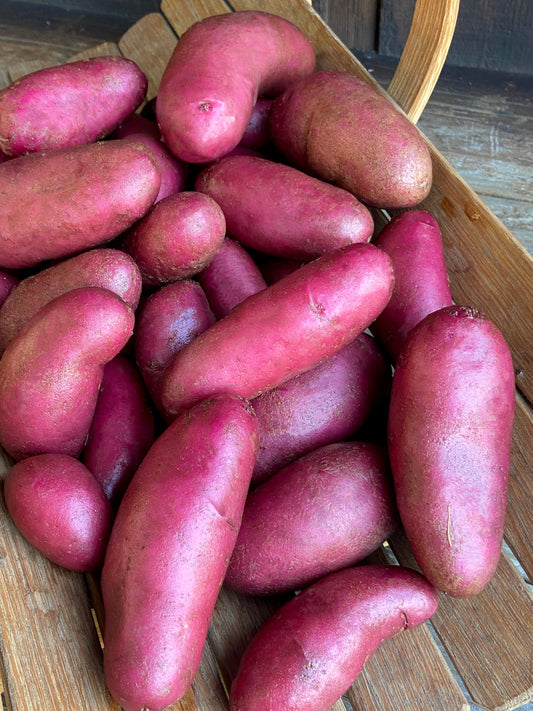 Sold out
Sold outAmarosa Fingerling
NEW THIS SEASON! These unique fingerling potatoes have smooth, ruby colored thin skins and marbled rose and pink flesh that keeps its pretty coloration when cooked. Amarosa’s interior texture is creamy smooth and nutty tasting, and they don’t fall apart when you cook them. Enjoy them in colorful potato salads, cooked and cut up into small cubes as a tasty accent for green salads, or simply steam and serve with butter and chopped parsley or chives.
Because of their rich interior color, these slender oblong fingerlings are particularly high in antioxidants. Amarosa fingerlings have demonstrated good scab resistance, moderate keeping ability and produce well across different climate zones. Their firm texture, excellent flavor and vivid color – both inside and out – makes them a wonderful home garden choice. If you have an air fryer – think pink potato chips!
Midseason: 85-95 days / Type: Determinate
1 lb. bag (plants a 10 foot row)
Mix and match your own potato patch:
Save 10% when you buy any 3 varieties or more!
Discount taken at checkout.NOTIFY ME WHEN AVAILABLERegular price $19.95Sale price $19.95Unit price / perSold out -

 Sold out
Sold outUmatilla Russet
NEW THIS SEASON! This fine Russet potato, named for the Native American Umatilla tribe, was developed 25 years ago by the Agricultural Experiment Stations of Idaho, Washington and Oregon. This variety reliably produces big, oval tubers with lightly russeted golden skin, shallow eyes and fine-grained white flesh. They are perfect for making delicious thick-cut oven fries or terrific baked potatoes with temptingly fluffy interiors – the best kind of nourishing comfort food! Heavy for their size, Umatilla tubers grate easily for making delectable potato pancakes or hashbrowns.
Umatilla is also more productive than other Russet varieties, reliably producing bumper crops of good-sized, uniform tubers on strong growing plants. They also store well for a long season of eating pleasure.
Late season: 95-125 days / Type: Indeterminate
1 lb. bag (plants a 10 foot row)
Mix and match your own potato patch:
Save 10% when you buy any 3 varieties or more!
Discount taken at checkout.NOTIFY ME WHEN AVAILABLERegular price $19.95Sale price $19.95Unit price / perSold out -
Heirloom Nasturtiums Alaska Mix
ANNUAL
Spring/summer/fall bloom
Frost tenderEASY TO START OUTDOORS
Sow seeds in spring once all danger of frost is over in full sun (or part shade in hot climates). Nasturtiums need no added fertilizer in most soils. Poke seeds into well-worked soil about 1 inch deep and 3 to 4 inches apart. Press soil firmly over the seeds and keep moist. When seedlings are large enough to handle, thin to 10 inches apart as mounding plants need ample room.
TO START EARLY INDOORS
Sow 2 seeds each in individual 4 inch pots of well-drained seed starting mix 3 weeks before last expected frost date. Cover 1 inch deep. Provide a strong light source. When seedlings have several sets of leaves pinch out the weaker seedling, leaving 1 per pot. When night temperatures reach 50ºF (10ºC), gradually acclimate to outdoors. Transplant seedlings into the garden 10 inches apart in full sun.
GROWING NOTES
These old-fashioned nasturtiums with handsome variegated leaves are easy to grow in any well-drained soil. Alaska’s softly mounding foliage and bright flowers will quickly fill garden beds and make a showy accent in planters or patio pots. Thinned to proper 10 inch spacing, they are a perfect disguise to cover fading bulb foliage in late spring.
Regular price $3.69Sale price $3.69Unit price / per -
Heirloom White Nigella Bridal Veil
HARDY ANNUAL
Spring/summer bloom
Can handle light frostEASIEST TO PLANT DIRECTLY IN THE GARDEN
Sow seeds directly into a finely textured, well-drained garden bed as early in spring as the ground can be worked. Space seeds 2 inches apart, in rows 6 inches apart. Cover seed very lightly, about 1/4 inch deep. Or broadcast seeds evenly over the seed bed and cover very lightly. Keep evenly moist while awaiting germination. Thin seedlings to stand 6 inches apart so plants have room to grow and mature. In mild winter climates, Nigella can be sown in early spring and also be sown again in cool fall weather to overwinter for spring bloom.
GROWING NOTES
Make several successive sowings from early spring through early summer and you'll have these carefree specialty flowers blooming all season long. As flowers fade, cut stems of the decorative seedpods. Hang carefully upside down in bundles out of the direct sun to easily dry for everlasting arrangements. Let some seedpods mature and stay on the plants to spill seed and these graceful flowers will come up year after year.
Regular price $3.69Sale price $3.69Unit price / per -
Hummingbird Foxgloves Carousel Mix
PERENNIAL
Late Spring/Summer bloom
Frost hardy USDA zones 4–9
START EARLY INDOORSSow seeds as thinly as possible in a container of seed starting mix. Cover 1⁄8 inch deep with mix, keep moist and between 60-70°F (16-21°C). Provide a strong light source until ready to plant into the garden.
Feed every 2 weeks with half-strength fertilizer. Once seedlings are large enough to handle, transplant 2 to 3 inches apart into individual pots. When plants are 3 to 4 inches tall, gradually acclimate to outdoor conditions and plant out in well-drained soil. Can also be planted in early/mid summer for bloom the following spring.
THIN OR TRANSPLANT
Space seedlings 12-15 inches apart so the plants have enough elbow room.
GROWING NOTES
Deer resistant foxgloves do well in light shade, dappled sunlight all day or full morning sun. They appreciate rich fertile soil and consistent moisture. In mild summer areas, they can handle full sun all day. Cut the softly colored spires of bloom often for lavish bouquets.
Encourage repeat bloom and flowering side shoots by cutting spent flower stalks at plant bases. Plants also self sow readily. A favorite of hummingbirds, butterflies and bumblebees!
Caution: Toxic if eaten.
Regular price $3.39Sale price $3.39Unit price / per -
Endless Bouquets Cut Flower Garden
NOTE
The seed mix is packed with a larger quantity of organic rice hulls to help space the tiny seeds. Before opening, shake canister thoroughly to mix them together.
HOW TO PLANT
As soon as ground can be worked in early spring, sow mix in ordinary garden soil in full sun. In mild climates, where the ground does not freeze hard in winter, seeds can also be planted in late fall to over-winter and bloom the next spring.
Prepare the planting area by removing all weeds, grass and large stones. Break up soil clumps and evenly loosen the top 2 inches of soil with a digging fork or shovel, then smooth out with a flat rake.
Shake can thoroughly, then scatter the contents thinly and evenly over prepared ground. Using your rake, lightly cover the seed mixture, about ¼ inch deep, and then lightly firm the soil. Water evenly with a gentle mist. Keep bed moist while awaiting germination and when the seedlings are small.
GROWING NOTES
Harvesting opening flowers regularly for bouquets will help to encourage repeat bloom. Plants will flower in succession and bloom much longer if watered regularly. At season’s end, allow spent flowers to form pods and then drop their seeds to bloom again next spring.
ANNUAL CUTTING FLOWER MIX
NAME MIX% TYPE HEIGHT COLOR Aster
(Callistephus chinensis)2 A 12 - 36" Blue/Pink/White/Purple Calendula
(Calendula officinalis)10 A 12 - 24" Yellow/Orange/Cream Bachelor Buttons
(Centaurea cyanus)8 A 12 - 36"
Blue/RoseWhite Godetia
(Clarkia amoena)2 A 10 - 18" Pink/White Clarkia
(Clarkia elegans)3 A 10 - 18" Pink/Lavender Plains Coreopsis
(Coreopsis tinctoria)3 A 12 - 36" Yellow-Maroon Cosmos
(Cosmos bipinnatus)7 A 36 - 60" White/Pink/Crimson/Rose Chinese Forget-Me-Not
(Cynoglossum amabile)10 A/B 18 - 24" Blue Larkspur
(Delphinium ajacis)3 A 12 - 36" White/Pink/Blue/Violet African Daisy
(Dimorphotheca aurantiaca)5 A 10 - 16" Orange/Salmon/White Poppy
(Eschscholzia californica)2 TP 12 - 18" Yellow/Orange Annual Gaillardia
(Gaillardia pulchella)2 A 12 - 24" Yellow-Red Baby's Breath
(Gypsophila elegans)8 A 8 - 18" White Sunflower
(Helianthus annus)
2 A 24 - 72" Yellow Strawflower
(Helichrysum monstrosum)
1 A 24 - 36" Yellow/White/Red/Pink Candytuft
(Iberis umbellata)
5 A 12 - 18" White/Pink/Violet Lavatera (Tree Mallow)
(Lavatera trimestris)2 A 24 - 48" White/Pink Alyssum Tall (Sweet Alyssum)
(Lobularia maritima)
5 TP 8 - 16" White Evening Primrose
(Oenothera lamarckiana)
1 B/P 24 - 60" Yellow Shirley Poppy
(Papaver rhoeas)
3 A 12 - 30" White/Pink/Red California Bluebells
(Phacelia campanularia)
1 A 8 - 20" Blue Black Eyed Susan
(Rudbeckia hirta)
5 A/B/P 12 - 36" Yellow Catchfly
(Silene armeria)
2 A/B 16 - 22" Pink Marigold
(Tagetes erecta)
3 A 12 - 16" Yellow/Orange/Maroon Zinnias
(Zinnia elegans)
5 A 12 - 36" White/Purple/Yellow/Orange/Red
Inert Material: Organic rice hulls
A = Annual B = Biennial TP = Tender PerennialRegular price $16.95Sale price $16.95Unit price / per -
Heirloom Pole Beans Rattlesnake & Purple Pole
START SEEDS OUTDOORS
In spring once weather is warm and settled and night temperatures stay securely above 55°F (13°C), plant seeds in well-worked, fertile soil in full sun. Erect strong stakes, tripod poles, or trellis at planting time for support. Plant seeds 1 inch deep and 4 inches apart along a trellis, or if planting around tripods or stakes, plant 4 to 6 seeds 4 inches from each pole, thinning seedlings to 3 best plants.
GROWING NOTES
Beans are easy to grow, but wait until spring weather is warm both night and day to plant them, because cold conditions prevent good germination. If first sowing comes up unevenly, replant right away; new seedlings will catch up quickly. Birds are often attracted to young bean seedlings, so watch carefully and protect with netting or floating row covers if necessary. Avoid cultivating plants or picking pods when plants are wet.
HARVEST AND USE
Both these heirloom pole varieties are heavy bearers, so harvest pods often. The more you pick, the more plants will produce. Harvest for snap beans when pods are well filled out, but bean seeds have not swelled in the pods. Cook just until tender to enjoy best flavor and texture. For dried beans, let some of the Rattlesnake bean pods fully mature and dry on the plants if you want to shell out the pretty mottled beans inside to enjoy in dried bean recipes and chili.
Regular price $3.69Sale price $3.69Unit price / per -
Long Keeping Onions Rainbow Trio
FOR BEST RESULTS
Sow seeds in early spring as soon as soil can be worked; in mild winter areas, seeds can also be sown in fall to overwinter for a head start in spring growth. To Start Early Indoors: Sow 1 in. apart in a container of seed starting mix and cover 1/4 in. deep. Provide a strong light source until seedlings are 2 to 3 in. tall. Transplant 4 in. apart, burying crowns 1 in. deep. To Start Outdoors: Sow seeds in well-worked, fertile soil in full sun. Space 1 in. apart in rows 8 in. apart. Cover 1/4 in. deep, firm soil well over seeds, and keep evenly moist. Thin seedlings gradually to a final 4 in. spacing, using the tasty thinnings.
GROWING NOTES
Before planting, thoroughly work compost or well-aged manure and bonemeal into the soil. Keep onions well weeded and mulch plants once soil warms up to conserve moisture. Feed onions lightly with an all-purpose fertilizer several times during the growing season.
HARVEST AND USE
Harvest midsummer when bulbs are sized up and about half the onion tops are bent over. Stop watering and bend the rest of the tops down. After another 7 to 10 days or when tops are dry, pull the bulbs. If possible, let the onions dry in the sun for 5 to 7 days. Store bulbs in a cool, airy place.
Regular price $3.99Sale price $3.99Unit price / per -
Heirloom Herbs Garlic Chives
PERENNIAL
Spring/summer/fall harvest
Frost hardyTO PLANT DIRECTLY OUTDOORS
In the cool weather of early spring, sow clusters of 7 to 10 seeds 8 to 10 inches apart in well-worked, fertile soil in sun or part shade. Cover 1/4 inch deep and press soil firmly over seeds. Keep evenly moist as seeds germinate slowly over several weeks. Emerging seedlings have slender, straight leaves.
TO START EARLY INDOORS
In early spring, sow seed thinly in a container of seed starting mix and cover 1/2 Inch deep. Keep evenly moist as seedlings slowly emerge and provide a good light source. Gradually acclimate to outdoor conditions before transplanting clusters of 7 to 10 seedlings, planting each cluster 8 inches apart.
GROWING NOTES
Garlic chives grow slowly at first, but soon mature into sturdy bright green mounds crowned with pretty white edible blossoms. After bloom finishes, shear entire plant back to 4 inches to encourage regrowth of tender new leaves. These hardy, self-sufficient plants are attractive additions to the flower or herb garden.Regular price $4.89Sale price $4.89Unit price / per -
Flower Power For Nature's Pollinators
NOTE
The seed mix is packed with a larger quantity of organic rice hulls to help space the tiny seeds. Before opening, shake canister thoroughly to mix them together.
HOW TO PLANT
As soon as ground can be worked in early spring, sow mix in ordinary garden soil in full sun. In mild climates, where the ground does not freeze hard in winter, seeds can also be planted in late fall to overwinter and bloom the next spring.
Prepare the planting area by removing all weeds, grass and large stones. Break up soil clumps and evenly loosen the top 2 inches of soil with a digging fork or shovel, then smooth out with a flat rake.
Shake the can thoroughly, then scatter the contents thinly and evenly over the prepared ground. Using your rake, lightly cover the seed mixture, about 1/4 inch deep, and then lightly firm the soil. Water thoroughly and evenly with a gentle mist. Keep soil bed evenly moist while awaiting germination and when the seedlings are small. Water regularly for best blossoms.
GROWING NOTES
Plants will flower in succession and bloom much longer if watered regularly. At season’s end, allow spent flowers to form pods and then drop their seeds to bloom again next spring.
ANNUAL POLLINATOR FLOWER MIX
INDIVIDUAL VARIETY NAMESMIX% Chinese Forget-Me-Not19.6Baby Blue Eyes19.6 Single Chinese Aster9.8 Cornflower, ‘Polka Dot Mix’9.8Shirley Poppy
7.8 Sweet Mignonette
7 Tidy Tips
4.9 Virginia Stock10 Creeping Daisy3 Clarkia3 Globe Gilia2.9 Lemon Mint2 California Bluebell2 Lacy Phacelia1.5 Tall White Alyssum1 Plains Coreopsis1 Inert Material: Organic rice hulls Regular price $16.95Sale price $16.95Unit price / per -
Terra Rosa
Terra Rosa is a full-sized, oblong variety with smooth, deep magenta skin and pink-red sweet, creamy flesh that ranks high for flavor. This high nutrient specialty potato is really handsome, but its good looks are not just skin deep, because Terra Rosa’s rich color means higher levels of bioactive antioxidants and protective carotenoids. They retain their rosy color and resist fading when cooked.
Great tasting Terra Rosa tubers are ideal for microwaving, frying and we love them as oven-baked fries. You’ll find them perfect to harvest early, at 1 1/2 to 2 inches, and quickly steam for a baby potato feast. Harvesting, some as new potatoes early won’t mean fewer big ones later either, because Terra Rosa offers strong yields. Stores well for later use.
Early to Midseason: 80-95 days / Type: Indeterminate
1 lb. bag (plants a 10 foot row)
Mix and match your own potato patch:
Save 10% when you buy any 3 varieties or more!
Discount taken at checkoutRegular price $19.95Sale price $19.95Unit price / per -
Heirloom Turnip Purple Top Milan
START SEEDS OUTDOORS
In early spring, as soon as ground can be worked, sow in well worked, fertile soil in full sun. Space seeds 1-2 inches apart in wide rows 6 inches apart. Cover 1/2 inch deep. Keep soil evenly moist and well weeded. Carefully thin seedlings early to stand 4-6 inches apart, giving them room to size up. Provide consistent moisture.
GROWING NOTES
Make a second spring sowing 10 days later, before summer heat. Protect with floating row covers if marauding birds or flea beetles that chew holes in the leaves are a problem. Sow again mid to late summer for fall harvest.
HARVEST AND USE
Begin harvesting when the turnips reach 2 to 3 inches in diameter. If weather turns unexpectedly hot, pull and store the roots in the refrigerator.
Note: Turnips are always spicier when the weather turns hot. Slice and sauté or steam; use in soups and stews, or (and this is our favorite) just cut them in quarters or large chunks, toss with olive oil, then roast in the oven until tender to bring out their natural sugars. Enjoy the tasty, nutritious green tops steamed or quickly braised.
Regular price $4.89Sale price $4.89Unit price / per -
Heirloom Slicing Cucumber Patty’s Marketmore
START SEEDS OUTDOORS
Plant heat loving cucumbers only when weather is warm and settled and night temperatures stay above 50°F (10°C). Amend soil well with aged manure or compost. Sow groups of 2 to 3 seeds 1 1/2 feet apart and 1 inch deep with 3 feet between rows. Thin to 1 strong seedling per group.
GROWING NOTES
Protect seedlings from marauding birds with plastic berry baskets, removing before plants get crowded. Shallow rooted cucumbers need ample and consistent moisture. Avoid overly wet or dry periods for good quality fruit. Growing cucumber vines up vertical supports gives you long, straight fruits and saves garden space.
HARVEST AND USE
Cut rather than pull fruits from vines before seeds are large inside. Harvest every few days for longest fruit production. These crunchy, sweet cucumbers are perfect to slice and enjoy for refreshing snacks, in salads and sandwiches. Eat within a day or two of picking for best taste and quality.
Regular price $4.89Sale price $4.89Unit price / per

